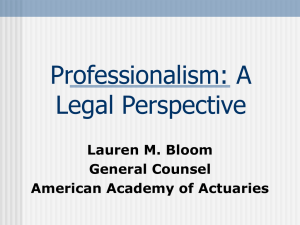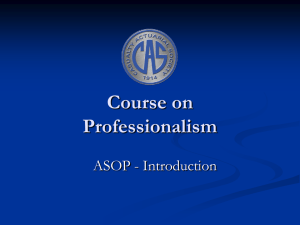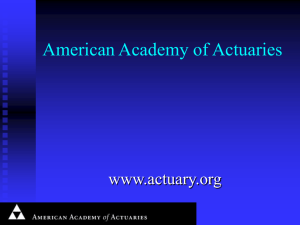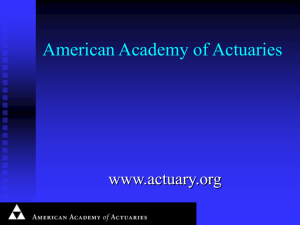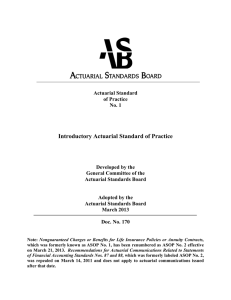Professionalism: A Legal Perspective Lauren M. Bloom General Counsel
advertisement
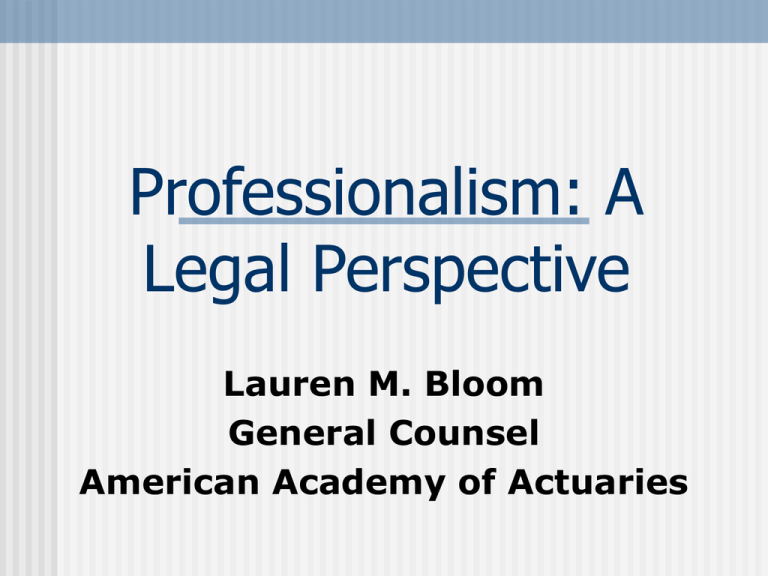
Professionalism: A Legal Perspective Lauren M. Bloom General Counsel American Academy of Actuaries Litigation against actuaries is increasing for several reasons: Actuaries are doing more; The weak economy has highlighted reserve shortfalls; American society is increasingly litigious; The plaintiffs’ bar has found the actuarial profession. Claims against actuaries are usually for malpractice: Failing to follow generally accepted practice; thereby Injuring a plaintiff to whom the actuary has a legally-recognized duty; Causing the injury in fact and law; and Generating compensable damages. Various defenses are available (e.g., plaintiff’s contributory negligence), but do not eliminate liability if the elements of malpractice are present. The more professional assignments an actuary undertakes, the greater his or her malpractice risk. Professional standards (the Code, ASOPs and Qualification Standards) are strong evidence of generally accepted practice. Failure to comply with the Code, Qualification Standards and ASOPs may be considered malpractice. To comply: Identify and read all applicable professional standards; Conform work to the standards or deviate and be prepared to explain; and Document, document, document. Which standards apply? The Code and Qualification Standards apply to all professional services rendered in U.S. The Code can also apply to practice abroad -- see draft white paper on international practice. Which ASOPs apply? The ASB’s ASOPs apply to U.S.based practice. Not all ASOPs apply to each assignment. Use the Academy’s Applicability Guidelines as a starting point. Two (non-casualty) ASOPs almost always apply: ASOP No. 23, Data Quality; and ASOP No. 41, Actuarial Communications. Keep the ASOPs close at hand when working, and follow recommended processes. If you deviate: Describe the nature, rationale and effect of the deviation in an appropriate actuarial communication; and Be prepared to defend it. Deviations can cause special problems in litigation. Documentation can be critical to successful malpractice defense. Documentation should (usually) include: A description of what was done and why; Sufficiently detailed work papers for another qualified actuary to review the work for reasonableness; A record of what the principal was told and when; Proof that open questions were asked and answered. Documentation should (usually) not include: Rough drafts of finished documents; “Back of the envelope” calculations; Evidence that outstanding questions were never asked or answered. Documentation: Can be maintained as part of an ongoing document retention policy do not destroy evidence! Will be reviewed with the benefit of hindsight. Helps you if it shows you complied with applicable law and standards. In litigation, standards help defendants who complied, but can hurt defendants who didn’t. The absence of published standards does not prevent litigation. The profession can mitigate its litigation risk through active participation in the standard-setting process. Actuaries can mitigate their risk of liability through: E&O Insurance Establishment of appropriate business relationships Recognition and adjustment for high-risk assignments Peer review Actuaries can mitigate their risk of liability through: Use of engagement letters Limitations on liability Arbitration clauses Third party indemnification Waiver of jury trial Limitation on use of work product Ownership of intellectual capital Billing and payment terms Enron and related cases have triggered: Adverse media attention for the accounting profession Shareholder anxiety Immediate and strong Congressional action Lessened respect for professions The Corporate Responsibility Act: Establishes Accounting Oversight Board Enhances auditor independence requirements Heightens management accountability Enhances financial reporting requirements Imposes stiffer penalties for misconduct by accountants, analysts and managers The Corporate Accountability Act also limits the ability of auditing firms to provide other services to their clients. Absent advance audit committee approval, an audit firm cannot provide: Bookkeeping services Financial information systems design Appraisal or valuation services Actuarial services Internal audit outsourcing services Absent advance audit committee approval, an audit firm cannot provide: Management/human resources functions Broker/dealer or investment advisor services Legal or expert services (unrelated to audit) Other services prohibited by Board. These restrictions may significantly change the role of actuaries working in audit firms. For most actuaries, however, the question will be how best to work with auditors in the post-Enron world. Auditors will be facing: Oversight from new Board New and untested rules and ethical codes Heightened scrutiny from press More inquiries from management, especially audit committees Increased potential penalties from various sources Management will be facing: Sensitized SEC Heightened media scrutiny Congressional concern Shareholder anxiety Personal culpability Ongoing demands to produce profits Actuaries can expect: More questions from auditors and management Ethical requirements in addition to the Code Additional documentation requirements (Maybe) more pressure to keep reserves low Actuaries will need to: Comply with applicable ASOPs Document work products and retain the documentation as required by law Be prepared to respond to questions Anticipate uncertainty until the new rules are sorted out Applicable ASOPs include: ASOP No. 21 (under revision) ASOP No. 23 ASOP No. 41 ASOPs relevant to the task at hand (e.g., ASOP 9,36) Use the profession’s tools: Practice Notes and Applicability Guidelines Consider a peer review program Call the ABCD for guidance when questions arise Keep current with publications and seminars Case Study You work for a large consulting firm. Client A of your Chicago office (where you are employed) is negotiating to purchase Client B of your Boston office. A & B both wish your firm to assist in the valuation of the assets and liabilities to be transferred to Client from Client B. A & B have both signed conflict waivers and your firm has established “Chinese walls,” though neither client requested them. Case Study (cont’d.) You are part of the consulting team working for A. While reviewing the sale documents, you discover a “typo” in the draft contract language prepared by your Boston office. The “typo” would increase the assets to be transferred to A by $50 million more than you think B intended to offer, and by $25 million more than the opening position A was prepared to put forward. Case Study (cont’d.) What are the ethical issues presented? What Precept(s) of the Code of Professional Conduct apply? What are your alternatives? Questions?
